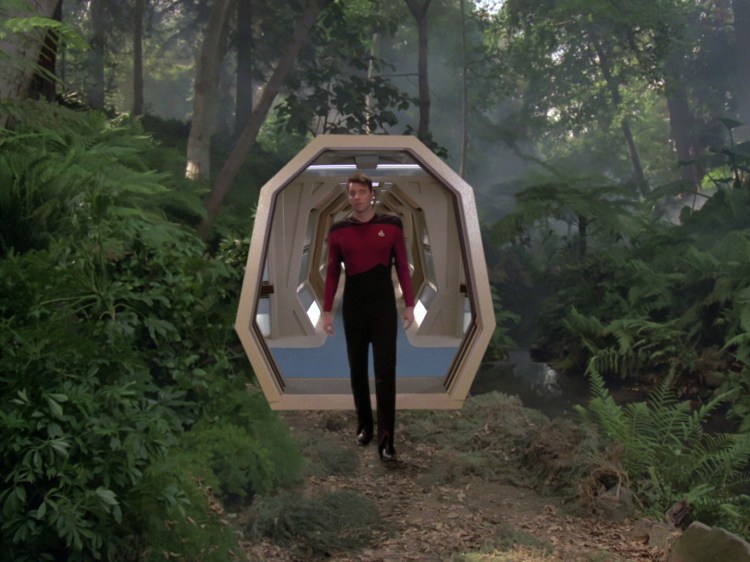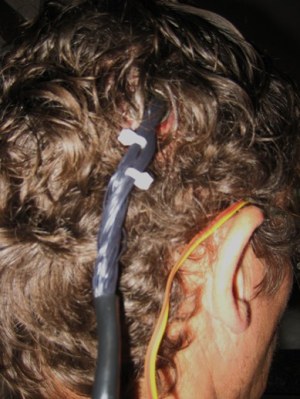Science-fiction writers have a challenge: describe the potential future. It’s exciting to read about our possible coming realities, but it’s often better when we actually catch up.
That is what’s happening with virtual reality. After decades of trying, we are finally making the concept of inhabiting a computer-generated environment work. Gaming startup Oculus VR is planning on releasing a version of its Oculus Rift headset for consumers later this year, and Sony just introduced its Project Morpheus at the Game Developers Conference in San Francisco this week. These devices go over players’ eyes and fill their vision with a stereoscopic 3D screen. The Rift and Project Morpheus also track movement so that when a wearer looks around, the image adjusts. We’ve tried both as well as some other VR-related peripherals, and it does feel something like entering another world.
With the VR revolution upon us, we wanted to look back and see what fiction predicted and how the reality compares. Star Trek‘s holodeck promised a lot. Will the real thing let us down? Let’s take a look.
‘Star Trek: The Next Generation’
How it works
On the Starship U.S.S. Enterprise in Star Trek: The Next Generation, crew members often seek recreation by entering the holodeck. This is a room that is capable of generating simulated environments and characters that real humans can talk with and touch.
In the fiction of the show, it works by combining several different future technologies, according to the Star Trek wiki Memory Alpha. Essentially, the machine projects light photons that are held in place by force fields that are so complex that they can replicate the feel of human skin and other materials. A thin force field on the floor even creates a treadmill-like effect that keeps users from running into the walls of the room. This helps the holodeck create the illusion of wide-open spaces.
In The Next Generation, characters often use the room to bring their favorite novels to life or to train in combat scenarios.
How it compares to what we have today
OK. Star Trek: The Next Generation is hundreds of years in the future. Here in the 21st century, we’ve barely got virtual reality working at all, and society still thinks that the Kardashians are entertaining. Obviously, we’re not as advanced as Captain Picard.
We cannot manipulate photons, and we cannot create force fields, but the holodeck is actually similar to today’s VR in a few key ways.
First, we have something similar to the holodeck’s force-field treadmill. It’s the Virtuix Omni, which is an octagon-shaped pad that sits on the ground that players can run their feet across endlessly. That movement is then translated into game controls that will also move your in-game avatar.
Check it out in action:
“One of the reasons why we started developing the Omni is to come closer to the holodeck experience,” Virtuix chief executive officer Jan Goetgeluk told GamesBeat. “We’re getting closer to that. To walk around the virtual world, you need what’s called an omnidirectional treadmill — a treadmill in 360 degrees. That’s what the Omni is.”
The second similarity is motion tracking. In order for the holodeck to know when to update the environment and to move the force field, it has to constantly track the position and movement of its users. This is one of the fundamentals of VR. The computer needs to know where you are, and the Oculus Rift is no different. It has a number of sensors to detect the tilt and direction the player is facing. Both the Rift and Morpheus use cameras to see when the gamer is leaning or moving laterally. Just as the holodeck makes changes based on user position, so does today’s VR tech.
Even Virtuix’s treadmill uses tracking.
‘The Matrix’
How it works
In the future, self-aware robots “grow” vast fields of people to use as batteries. To keep the population mentally active and placated, the robots plug the humans into a computer simulation that re-creates the late 1990s. Almost everyone lives their entire existence within this system, but a fraction have escaped the prison. They can jump back into The Matrix at any time by plugging their brains back in through a port on the back of their head.
This virtual reality would require computers that can interface with the human brain, and it would have to keep track of each individual’s body and vital organs.
How it compares to what we have today
The Matrix definitely emphasized the fiction bit in “sci-fi,” but that doesn’t mean it doesn’t relate back to real-world technology.
For example, since The Matrix is happening on some kind of central server and not just in the player’s brain, the computer would have to understand what was going on in each person’s body. That would require its system to measure biometrics, which is a way of measuring a human’s heartbeat, core temperature, caloric levels, and more — and we have that today.
“There was a Kickstarter campaign recently for a game called Nevermind that wasn’t successfully funded, but their plan was to take biofeedback to steer the game,” said Goetgeluk. “For example, it could measure your heart rate, and then if it goes up, it means that you’re getting scared or excited, and games can use that information to steer themselves, to make it even more frightening.”
Check it out:
Another aspect of The Matrix that echoes reality — even if it isn’t used in today’s virtual reality — is how characters like Neo and Trinity have digital ports in their heads that enable them to plug into the digital world. We have brain-computer interfaces today. The most extreme example of this is probably the titanium jacks that doctors implanted in skull of Jens Naumann, a blind man, that helped him regain his vision for eight weeks back in 2002.
Research doctors in Portugal wired up an electrode in Naumann’s brain to a data jack that they could plug a camera into. This enabled Naumann to see the outlines of objects.
Google engineer and futurist Ray Kuzweil is a proponent of the idea that we will one day be able to fully upload our brains into virtual reality.
“By 2020, we’ll have the computing power to simulate the human brain for $1,000,” he said in a presentation to the Massachusetts Institute of Technology’s BCI workshop. “By then, cloud computing will be very mature. We’ll have plenty of hardware as we go forward. The only issue is whether we’ll have the software.”
Kurzweil thinks we’ll reverse engineer the brain by 2019, and then we’ll have the capability to interface in something like The Matrix not too long after that — and it all starts with brain-computer interfaces like the one in Naumann’s head.
‘The Lawnmower Man’
How it works
In the near future, Dr. Lawrence Angelo experiments with virtual reality to increase intelligence. He’s tested it on chimps, and the plot of the film follows his secret tests on a greenskeeper named Jobe Smith, who has a learning disability. Smith does games and exercises in VR that make him not only smart but super-intelligent.
The virtual reality in The Lawnmower Man requires players to wear head-mounted displays. To move around in the games, Jobe uses flight sticks and sometimes special gloves that track his movement. Later in the movie, Jobe gets to use a much more advanced VR machine that has him in a full body suit and an aerotrim (one of those gyroscope type things that astronauts use to prepare for space) that gives the user a full sense of immersion in the alternate reality.
How it compares to what we have today
Compared to Star Trek and The Matrix, The Lawnmower Man has the most rudimentary form of virtual reality, which also makes it the closest to what we actually have today.
Like Jobe, we will likely use joysticks to control our in-game motion. In fact, one of the few confirmed games for Oculus Rift and Project Morpheus is the space-dogfighter Eve: Valkyrie, which has players piloting a nimble starship using a flight stick.
Of course, the other obvious similarity is that all of our VR solutions, like those in The Lawnmower Man, are head-mounted displays. The movie predicts that to immerse a person in a video world, they would need to have their vision totally engulfed in an audio-visual helmet.
Like The Lawnmore Man‘s device, Oculus Rift and Project Morpheus will put a 3D screen right on top of your eyes. Oculus VR is aiming to have a display capable of reproducing a player’s full field of view, while Sony said that the early Project Morpheus has a screen that will take up 90 degrees of your vision. Human eyes typically have a 110-degree viewing angle.
The bodysuit that Jobe wears is also something that is in development … kind of. The one in the film mimics touch and feel while also tracking movement. In one scene, the film implies that the outfit is fully capable of simulating the sensations of sex. We don’t have anything like that, but haptics — or the use of touch to provide feedback in an user-interface system — is something that many tech companies are working on. The 3rd Space vest from TN Games provides the sensation of being hit by something when a player wears it. The technology simulates different levels of damage as well as the direction that an attack is originating from, and it is already compatible with games like Call of Duty and Dragon Age: Origins.
Virtual reality in the future
Not everything in The Lawnmower Man is accurate — well, besides the fact that, spoiler warning, VR eventually gives Jobe the ability to move things (and set things on fire) with his mind and then he becomes a techno god who is one with all connected devices. But we are clearly on the cusp of having most of the technology in that film.
Kurzweil thinks that we’ll have the technology to upload ourselves into machines before 2050. At that point, he believes virtual reality will replace our own and we will only venture out into the “desert of the real” as robots when we are hundreds of years old.
Finally, will we ever get the holodeck? Well, we probably won’t need it if Kurzweil is right. If he isn’t, we are still very far off from technologies like tractor beams and force fields. That might actually take until the 24th century.
VentureBeat's mission is to be a digital town square for technical decision-makers to gain knowledge about transformative enterprise technology and transact. Learn More







![Reblog this post [with Zemanta]](http://img.zemanta.com/reblog_e.png?x-id=063f8f9f-f285-410b-bee7-2c07ecac6520)
